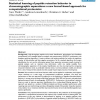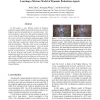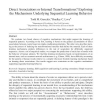176 search results - page 3 / 36 » Modeling and Predicting Learning Behavior in MOOCs |
BMCBI
2007
13 years 4 months ago
2007
Background: High-throughput peptide and protein identification technologies have benefited tremendously from strategies based on tandem mass spectrometry (MS/MS) in combination wi...
CVPR
2012
IEEE
11 years 7 months ago
2012
IEEE
In this paper, a new Mixture model of Dynamic pedestrian-Agents (MDA) is proposed to learn the collective behavior patterns of pedestrians in crowded scenes. Collective behaviors ...
ISWC
2002
IEEE
13 years 9 months ago
2002
IEEE
The Parasitic Humanoid (PH) is a wearable robot for modeling nonverbal human behavior. This anthropomorphic robot senses the behavior of the wearer and has the internal models to ...
COGSCI
2010
13 years 4 months ago
2010
We evaluate two broad classes of cognitive mechanisms that might support the learning of sequential patterns. According to the first, learning is based on the gradual accumulation...
ICMLA
2008
13 years 6 months ago
2008
Learning by imitation has shown to be a powerful paradigm for automated learning in autonomous robots. This paper presents a general framework of learning by imitation for stochas...



